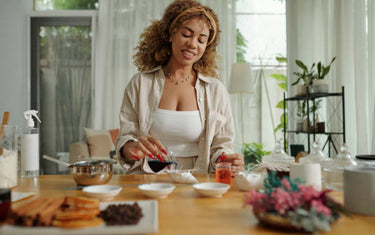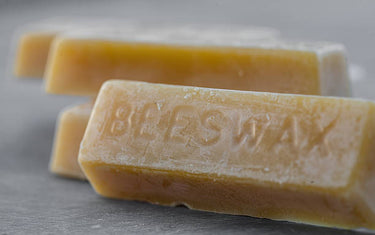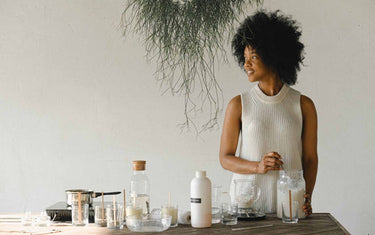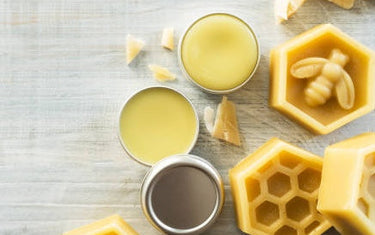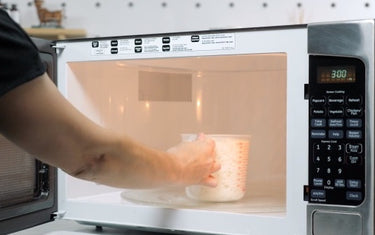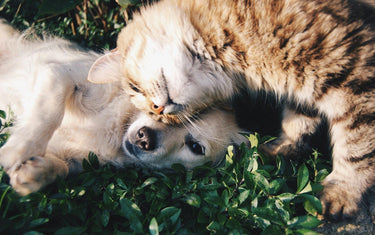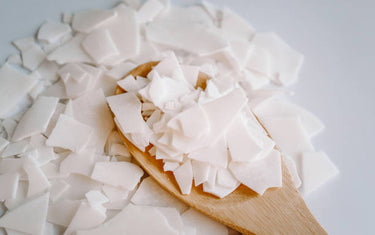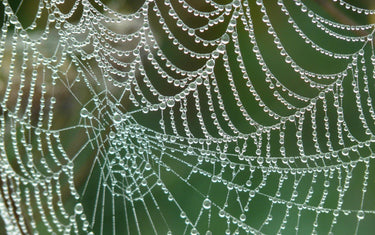7 min read / 16 April 2025 / yasmin sharp
How to Make Bubble Bath
Learn how to create your own natural, chemical-free bubble bath at home using simple ingredients like castile soap and essential oils for a relaxing and skin-friendly bathing experience.
Share this post
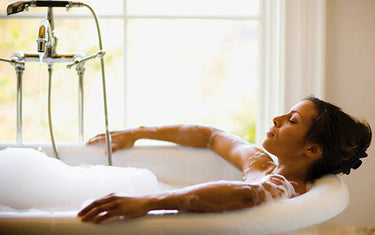
Stepping into a bath filled with bubbles is like escaping into your own private world of comfort, a place where you can wind down, relax and focus on your selfcare for a while.
Not everyone is a fan of using brand name bubble bath products, especially if you have sensitive skin and are wary about coming into contact with certain chemicals.
Your best option could be to learn how to make your own bath bubbles, and in this guide, we show you exactly how to do that and give you a handful of simple recipes you can whip up in a matter of minutes.

What are the benefits of a bubble bath?
Stress relief and relaxation
When you use aromatherapy oils for your bath, the warm, calming sensation of the water and bubbles can relax your mind and help you to feel more tranquil. Researchers in Japan [1] found that in comparison to taking a shower, bathing not only improved their skin, but it also helped to decrease fatigue and stress.
Better blood circulation
Immersing yourself in a bath filled with relaxing bubbles and warm water can also help to dilate blood vessels, improving blood flow to the skin. One study [2] highlighted how half-body bathing in warm water boosted circulation amongst participants in the short-term, helping to nourish the skin.
Pain relief support
Taking a warm, bubble-filled bath can provide pain relief, which could be helpful for people with rheumatoid arthritis. For example, this study[5] learned that immersion in hot water – which includes taking a bath – provided significant therapeutic relief for 83.2% of the 1,064 participants with musculoskeletal disorders.
Chemical-free natural alternative
When you buy bubble bath from a store, the ingredients will often include something called sodium laureth sulphate, which is not always suitable for people with sensitive skin. [6] When making homemade bubbles for your bath, use a liquid soap that is designed for sensitive skin – perhaps something you’ve used in the past would be a good choice.
We’ve used castile soap in our recipe below, as it includes jojoba oils, olive and hemp, whilst also being nontoxic, vegan-friendly and biodegradable.
What makes the bubbles in a bubble bath?
Before you learn how to make your own bubble bath, it’s helpful to know how they are formed in the first place.
Every bubble has two layers of soap molecules that are wrapped around a thin layer of water molecules. And when you add your essential oils bath mixture to the stream of running water coming from the tap, this will produce a bigger set of bubbles.
The best part is, the more bubbles you have, the warmer the bath can be, as the bubbles help to trap and insulate the warm water for longer.
Are there any safety concerns for a bubble bath?
There are not many risks involved with taking a bath, although you should ensure that the temperature is okay for your body – which applies to it being both hot and cold.
If you are worried about the ingredients used in store-bought bubble bath products, you may want to consider making your own at home. Homemade bubble baths are inexpensive and easy to make and ideal for people with sensitive skin, allergies or anyone who has general concerns about exposing their bodies to chemicals.
Before you use your own bubble bath, carry out a patch test to ensure that the ingredients are compatible with your skin. If you do not see any reaction, such as redness, inflammation or itchiness, it should be safe to use.
Some research has highlighted that certain ingredients can lead to a urinary tract infection in adults [3] and children [4] , although due to the limited evidence it is still believed that the enjoyment you get from a bubble bath outweighs the suggested harms.

How to make an easy bubble bath
For this simple and easy bubble bath recipe, you’ll only need a few things:
Bubble bath ingredients
Serving: 295ml (approx.)
- ½ cup warm distilled water
- ½ cup liquid castile soap
- ¼ cup vegetable glycerine or coconut oil
- 10-15 drops of your choice of essential oils (optional)
- 20-30ml of your chosen carrier oil
If you struggle to find glycerine for your recipe, you could try using coconut oil instead, which is also good for moisturising skin.
Instructions
- Gather all the ingredients you need for your bubble bath.
- Mix the distilled water, liquid castile soap and vegetable inside a container.
- Shake well, keeping an eye on the glycerine which can sometimes settle at the bottom.
How to use your DIY bubble bath
- Before you add your essential oils bath bubbles to the water, give the container a little shake to blend in the glycerine.
- Try not to over-shake the bottle as this can make it too foamy and bubbly.
- Pour the bubble bath slowly into the running water – adding small amounts at a time until you have the right level of homemade bubbles for your bath.
How to personalise your bubble bath
There are lots of ways you can personalise your bubble bath so you can make it just to your liking. Why not try some of the below:
Add an essential oil or two
Using essential oils for baths will add a wonderful fragrance that can make your downtime even more enjoyable and relaxing. Lavender or chamomile are recommended picks, as they are mild and kind to skin.
For every 5 drops of essential oil, add at least 10 ml of carrier oil of choice and blend with your bubble bath mix before pouring it into the running water.
Pour in some carrier oils
Another way of using aromatherapy oils for baths is to mix in a carrier oil like vitamin E, jojoba or almond. These are all great for the skin and bring their own skin-boosting properties that can make skin look and feel healthier.
Use a honey and egg mixture
Honey is a natural humectant, which means it helps to attract and retain moisture in the skin. And if you want to create a nice, fluffy bubble bath with stronger, longer-lasting bubbles, you could consider adding some egg white.
Mix in a little aloe vera
Aloe vera is well-known for its skin moisturising properties, so adding a small amount to your bath could work wonders. Try blending it in with your bubble bath to enjoy a soothing and relaxing session – and if you’ve caught a little too much of the sun it can help to cool your skin.
Try Epson salts or magnesium
If you’ve had a long, tiring day or are trying to recover from a strenuous gym workout, using Epsom salts or magnesium flakes can be godsend for sore muscles. One study highlighted [7] how magnesium is especially good at boosting hydration levels and easing inflammation.
Calm your skin with coconut milk
Coconut offers anti-inflammatory properties [8] that when added to a bubble bath can help to calm conditions like eczema, psoriasis or rosacea. Even if you do not have any of these conditions it can leave your skin feeling moisturised, soft and smooth after you step out of the bath. Consider taking a patch test before you use it, especially if you have a nut allergy.
More easy bubble bath recipes
Bubble bath for sleep
- ½ cup warm distilled water
- ½ cup liquid castile soap
- ¼ cup vegetable glycerine or coconut oil
- 10-15 drops (total) lavender essential oil and/or chamomile essential oil
- 20-30ml of your chosen carrier oil
As with our recipe above, mix all the ingredients together, slowly add to running water and store in a reusable container.
Bubble bath for stress and anxiety
- ½ cup warm distilled water
- ½ cup liquid castile soap
- ¼ cup vegetable glycerine or coconut oil
- 10-15 drops (total) clary sage essential oil and/or bergamot essential oil
- 20-30ml of your chosen carrier oil
Bubble bath for mood boost
- ½ cup warm distilled water
- ½ cup liquid castile soap
- ¼ cup vegetable glycerine or coconut oil
- 10-15 drops (total) lemon essential oil and/or ylang ylang essential oil
- 20-30ml of your chosen carrier oil
Bubble bath for skin
- ½ cup warm distilled water
- ½ cup liquid castile soap
- ¼ cup vegetable glycerine or coconut oil
- 10-15 drops (total) of your preferred essential oil
- 20-30ml of your chosen carrier oil
Depending on how you want to help your skin could use: chamomile essential oil (dry skin), rosemary oil (oily skin), eucalyptus oil (skin rashes), frankincense oil (sensitive skin) or myrrh oil (anti-ageing).
Bubble bath for kids
- ½ cup warm distilled water
- ¼ cup liquid castile soap (look for unscented brands for babies)
- ¼ cup vegetable glycerine or coconut oil

Final thoughts
Once you’ve learnt how to make an easy bubble bath, there really is no going back. All you need is a handful of basic ingredients and a few minutes of your time and you can enjoy hours of tension-free relaxation in a foam-filled world of joy.
You can also use aromatherapy oils for your bath, along with a host of natural ingredients that will treat your skin with the kindness it deserves.
And if you are using any ingredients for the first time, it is advisable that you carry out a patch test, just so you have confidence that your skin won’t give you any unexpected surprises once you are immersed in the water.
[1] https://pmc.ncbi.nlm.nih.gov/articles/PMC6011066/
[2] https://pmc.ncbi.nlm.nih.gov/articles/PMC9535243/
[3] https://pmc.ncbi.nlm.nih.gov/articles/PMC3749018/
[4] https://pmc.ncbi.nlm.nih.gov/articles/PMC2066009/
[5] https://pubmed.ncbi.nlm.nih.gov/34649472/
[6] https://medicine.uq.edu.au/article/2019/12/what-sodium-lauryl-sulfate-and-it-safe-use
[7] https://onlinelibrary.wiley.com/doi/abs/10.1111/j.1365-4632.2005.02079.x


